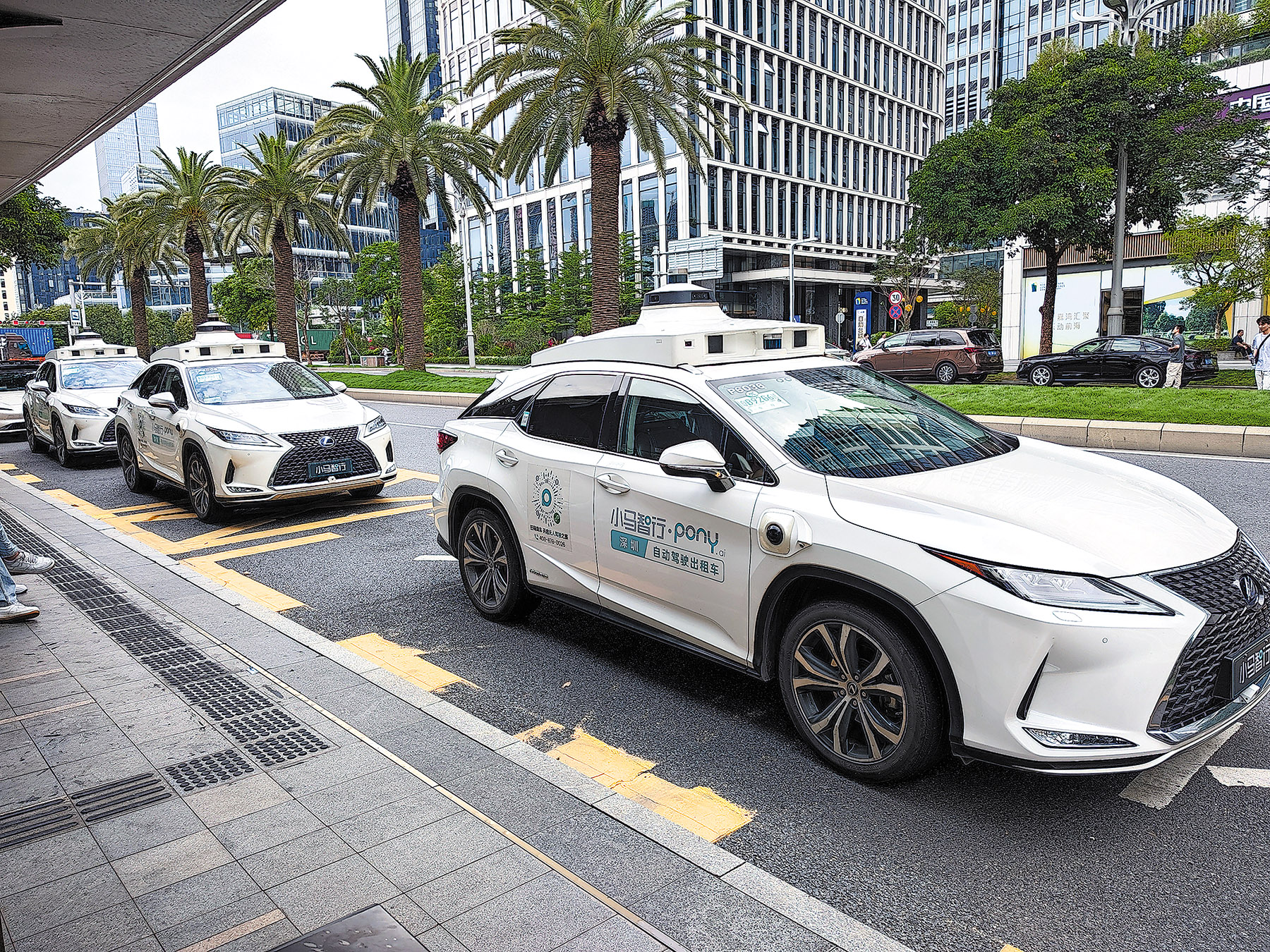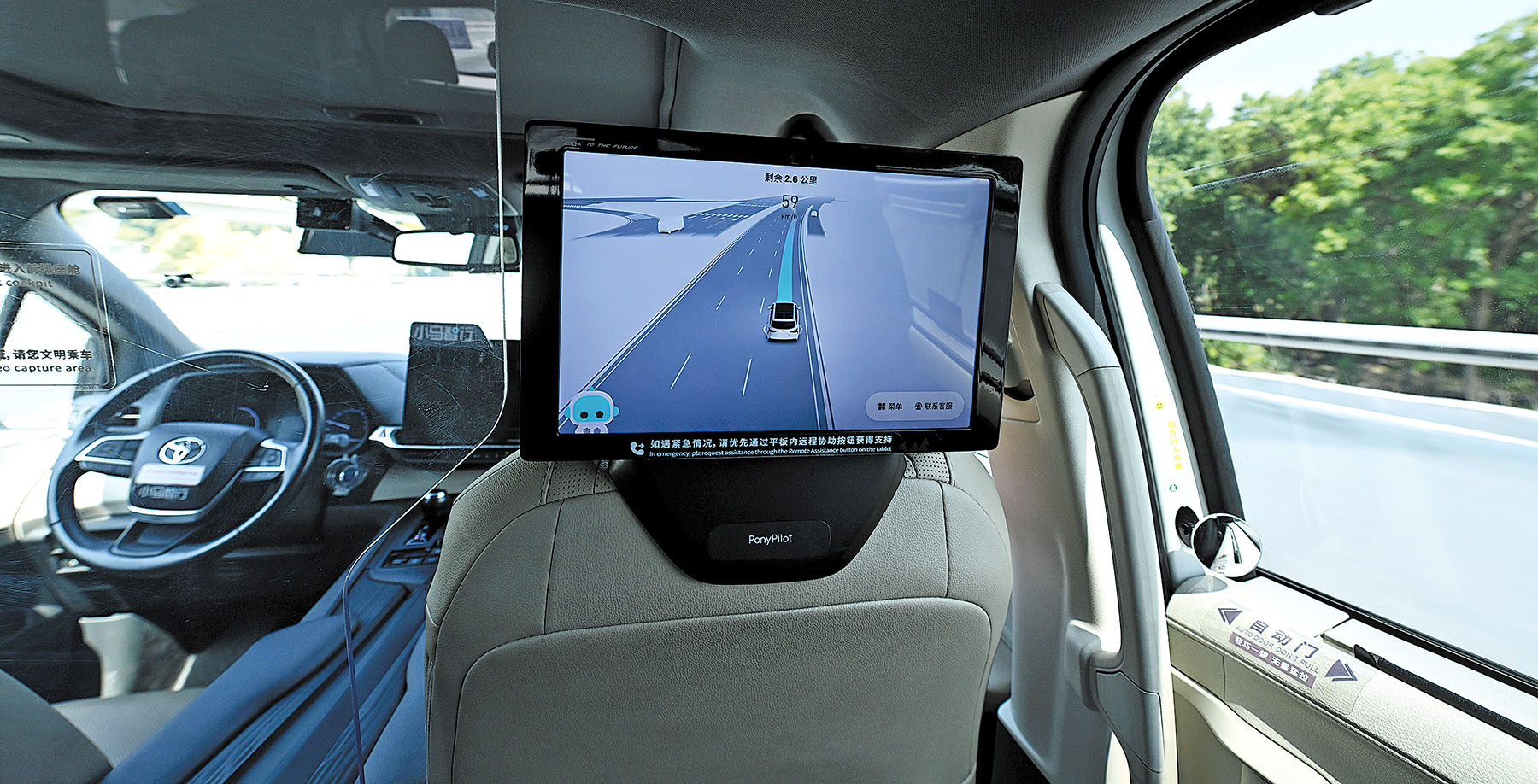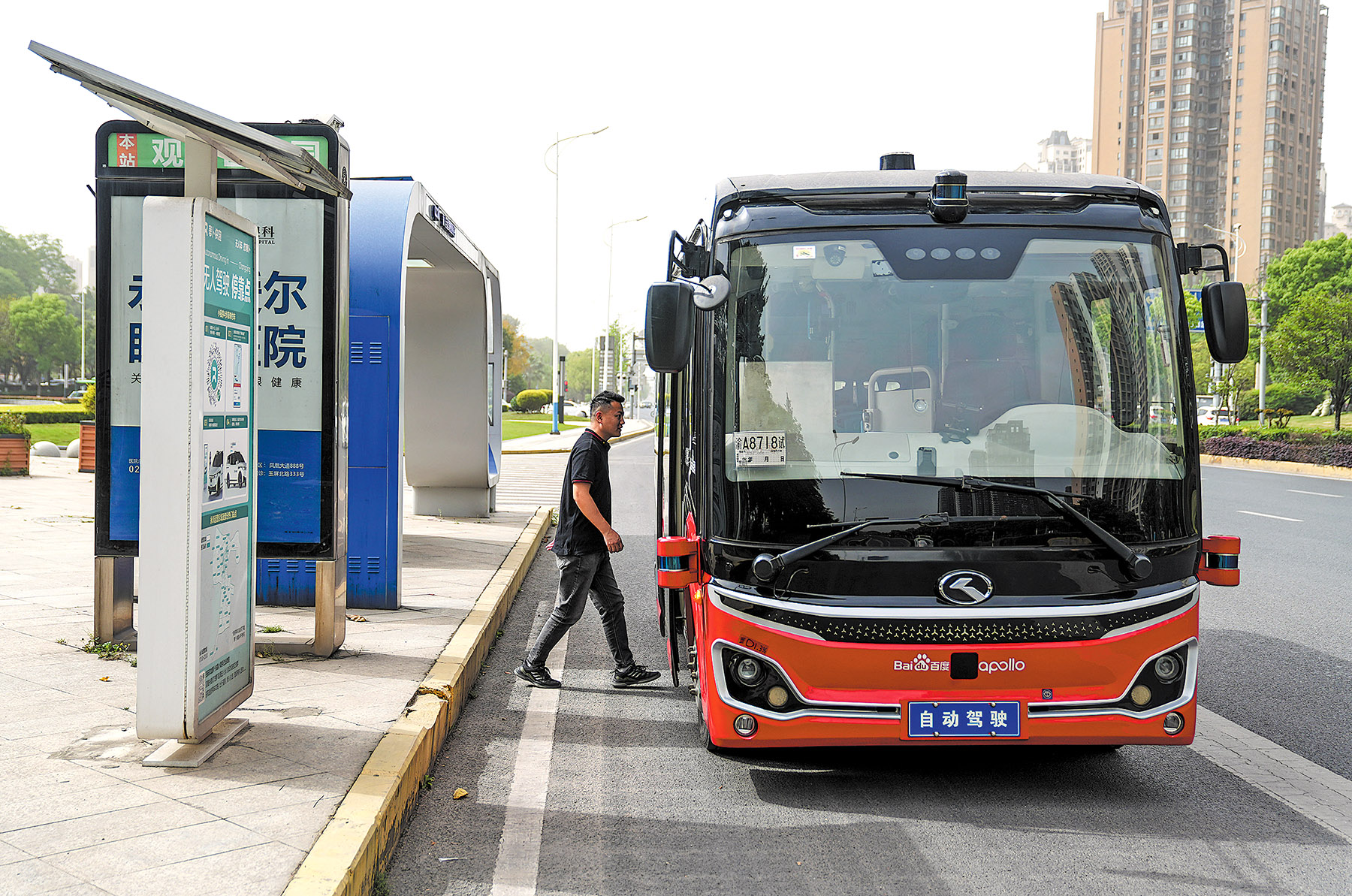Vast domestic development, favorable policies, tech prowess propel global reach

On a brisk Friday morning in early September, a fleet of light blue cars glided quietly in front of the Amiri Diwan — the imposing building housing the seat of governance — in Doha, capital of Qatar.
For most passersby, the sight probably looked like nothing more than regular vehicles navigating through traffic. But for Pony.ai, the fleet marked something bigger — the official start of its robotaxi testing in the Middle Eastern country.
The leading Chinese autonomous driving company has formed a strategic partnership with Qatar's national transport company, Mowasalat, to advance autonomous driving technology and vehicle deployment in Qatar.
The collaboration came two months after Pony.ai's partnership with Dubai's Road and Traffic Authority in the United Arab Emirates. Robotaxi tests will start later this year, with driverless robotaxis scheduled to start commercial operations in 2026.
READ MORE: Self-driving firms steer toward globe
Pony.ai's expansion is part of a broader trend of Chinese autonomous vehicle companies stepping beyond their home market at an accelerating pace.
In early September, WeRide announced its robotaxis would soon arrive in Singapore. The autonomous driving company, based in Guangzhou, Guangdong province, said the vehicles will be deployed later this year with a local mobility service provider.
The robotaxis follow the start of WeRide's robobus service on Singapore's Sentosa island in July.
The robobus, equipped with 360-degree vision and capable of detecting obstacles more than 200 meters away, operates on a fixed 1.2-kilometer loop every 12 minutes, connecting three hotels and T Galleria shopping mall.
Since late last year, WeRide's robosweepers have been working along Marina Coastal Drive and at the Esplanade, as Singapore's first commercial autonomous sanitation projects.
Chinese companies have also joined hands with global ride-hailing platforms like Uber to speed up their rollout and expand the availability of their services.
During the International Motor Show Germany, officially known as IAA Mobility, in Munich this month, Momenta, backed by investors such as Mercedes-Benz and SAIC, said it would begin rolling out robotaxi services on the Uber network in early 2026, starting in the German city.
The initial deployments will have safety operators onboard. "This partnership completes a critical piece of our global scaling puzzle," said Cao Xudong, Momenta's founder and CEO.
Uber CEO Dara Khosrowshahi described the deal as a significant step toward delivering "more reliable and affordable autonomous mobility" to users worldwide.
Toyota-backed Pony.ai is partnering with Uber as well, and is expected to first launch its service in a key market in the Middle East later this year, with a goal of scaling deployments to additional international markets in the future.
WeRide is expanding its existing cooperation with Uber to 15 additional cities outside China and the United States over the next five years.
The two companies started their cooperation in September 2024, and launched commercial robotaxi operations in Abu Dhabi, United Arab Emirates, last December, with the fleet to include 50 vehicles by mid-2025.
"We are taking this partnership to a new level," said Tony Han, founder and CEO of WeRide. "This reflects our joint ambition to make autonomous mobility accessible and affordable across the globe."

Domestic strengths
The flurry of announcements signals the start of the globalization of China's autonomous driving sector.
Over the past years, China has become one of the most vibrant testing grounds for autonomous vehicles, with dozens of companies piloting robotaxis in cities from Beijing and Shanghai to Wuhan in Central China's Hubei province and Guangzhou in South China's Guangdong.
Statistics show that as of August 2024, Chinese public security authorities had issued 16,000 test licenses for autonomous vehicles and more than 32,000 km of roads had been opened for testing across the country.
"Autonomous driving is a national strategic priority. Policies like the 14th Five-Year Plan for the Development of the Digital Economy and directives supporting AI demonstration projects clearly define the technology development path," said Zhang Ning, Pony.ai's vice-president.
Zhang, who is also head of the company's Beijing R&D center, said over 50 Chinese cities have local regulations supporting testing and commercialization, with 20 cities designated for integrated "vehicle-road-cloud" pilot programs. This scale is not seen in any other country.
The favorable policies, combined with China's edge in computer and artificial intelligence-related technology and its vast population and complex road conditions, have seen autonomous driving companies making rapid progress.
In April, Pony.ai unveiled its seventh-generation automotive-grade system at the Shanghai auto show. With a designed life of 10 years or 600,000 km, it features a 70 percent reduction in hardware costs compared with the previous edition, said the autonomous driving company.
Its autonomous vehicles have accumulated over 50 million km in mileage, including daily commercial operations in some of China's megacities, including Beijing and Shanghai, as well as testing in other parts of the world.
China also boasts a pool of outstanding talent in the autonomous driving sector and the wider technology sector.
In late August, James Peng, Pony.ai's founder and CEO, was named on the TIME AI 100 list, recognizing him as one of the most influential figures in AI globally.
Also on the list were also Huawei founder Ren Zhengfei, Unitree Robotics CEO Wang Xingxing and DeepSeek CEO Liang Wenfeng.
In the same month, WeRide's founder and CEO Han was invited by the Singaporean government to join the country's steering committee on autonomous vehicles. The committee brings together leaders from the autonomous vehicle and public transport industries, union representatives, and various government bodies to guide the progressive rollout of autonomous vehicles in Singapore.

Rapid replication
Zhang from Pony.ai said the current technological readiness of autonomous driving enables rapid replication and deployment, forming the foundation for commercial exploration in overseas markets. Many countries outside China and the US are actively promoting autonomous driving to address challenges such as aging populations, creating new opportunities for technology deployment abroad, he said.
Pony.ai emphasizes that international expansion is driven by commercial opportunity, not for the sake of expansion itself, Zhang said. "Expanding internationally at this stage allows technology to reach more users and regions, generating social and economic impact," he said.
Pony.ai prioritizes countries with a strong willingness to develop the autonomous driving technology and open policies that embrace innovation, he said. Other considerations include well-developed road infrastructure and existing automotive and electronics supply chains.
Countries facing aging populations or driver shortages also present significant market and transformation opportunities, said Zhang.
"Selected overseas markets — including the Middle East, Europe, Singapore and South Korea — share characteristics such as economic development, open policies and well-maintained infrastructure," he said.
Markets such as the Middle East and Southeast Asia are particularly attractive.
In Abu Dhabi, regulators have rolled out "green channel" policies to fast-track approvals, enabling WeRide and Pony.ai to launch pilot fleets of robotaxis and driverless buses.
Singapore, with its well-established tech ecosystem and controlled urban environment, has positioned itself as a laboratory for next-generation mobility.
By gaining a foothold in these regions, Chinese companies can showcase their technology in real-world settings, while also building brand recognition far beyond their home base.
Sharing risks
The strategy also reflects pressure from investors. For venture-backed companies in a capital-intensive industry, "going global" serves as a compelling narrative to demonstrate growth potential and resilience.
International expansion is not just about new roads to drive on — it is about staying in the race for relevance and survival in a sector where timelines are long and costs are enormous.
WeRide, in a written reply to China Daily, acknowledged that expanding internationally provides "rich opportunities for financing and business development". It echoed Pony.ai's Zhang's answer that "international expansion is driven by commercial opportunity".
That also explains in part why Chinese autonomous driving companies are partnering with global mobility giants like Uber, which is seen as a win-win and risk-sharing solution, to make inroads into overseas ride-hailing markets.
According to the McKinsey Center for Future Mobility, robotaxis are expected to become commercially available on a large scale by 2030.
For Uber, which has wound down its own in-house autonomous driving unit, the partnerships represent a strategic bet on outsourcing core technology while focusing on network scale and user engagement, said analysts.
"First, it must be affordable for consumers, but at the same time, it also needs to be profitable for service providers," said Philipp Kampshoff, a senior partner at McKinsey.
Southeast Asian super-app Grab, which offers ride-hailing and food delivery services, announced in August that it will invest tens of millions of dollars in WeRide, in a deal aimed at speeding up the rollout of Level 4 robotaxis and other self-driving vehicles across Southeast Asia.

Roadblocks in US
While Chinese autonomous driving enterprises expand actively overseas, US companies have largely remained focused on domestic operations.
Waymo, owned by Alphabet, operates its Waymo One robotaxi service in Phoenix, Arizona, and San Francisco in California. It is testing logistics fleets under Waymo Via, but has yet to establish a commercial presence outside the US.
Similarly, Cruise, backed by General Motors, concentrates on California and Arizona, where regulatory frameworks and urban infrastructure are familiar and predictable.
The contrast is striking. Chinese companies such as WeRide, Pony.ai and Baidu pursue a "dual track" strategy: maintain domestic leadership while entering selected foreign markets where pilot programs are feasible and government support is accessible.
This divergence stems from fundamental differences in market structure and strategic incentives.
In the US, the domestic market is fragmented, concentrated in a very limited number of cities including Los Angeles, Phoenix and Austin, Texas.
It is also hindered by complex, inconsistent state and local regulatory hurdles and concerns about the safety and reliability of autonomous vehicle technology following high-profile incidents, such as those involving Tesla's Autopilot, resulting in challenges in achieving widespread public acceptance and trust.
In contrast, Chinese companies have accumulated extensive experience in the home market over the years because of China's favorable policies and complex road conditions.
WeRide, for example, operates Robotaxi networks across core urban areas, transportation hubs and large communities in countries including China, the UAE and Switzerland, and has accumulated over 2,200 days of safe operation.
Other countries have shown interest in the new technology, and are both technologically and strategically ready for the rollout of products and technologies.
Pony.ai's Zhang said he believes that Chinese companies have "inherent advantages" when exploring overseas markets.
The combination of high population density, heavy traffic and complex road conditions in China has enabled local companies to handle difficult scenarios. A mature automotive industry and advanced vehicle intelligence also help facilitate faster deployment in foreign markets, said Zhang.
"The robotaxi industry may appear crowded and fiercely competitive, but in reality, the technical barriers are extremely high, so there are actually only a handful of true players at the table — and China's autonomous driving technology is among the most advanced in the world," he said.
Technical adaptation
Despite early successes, overseas expansion will not be without bumps for Chinese autonomous vehicle companies, said analysts.
One thing is technical adaptation. Systems calibrated for Chinese megacities may require substantial recalibration for Singapore, Abu Dhabi, or other foreign urban environments, they said.
Also, regulatory uncertainty persists. Even in markets that appear welcoming, policy changes can occur quickly, potentially limiting operational scope or requiring costly adjustments. Compliance with local safety and liability standards adds complexity to international operations.
ALSO READ: Pony.ai eyes bigger robotaxi fleet for edge in self-driving
The right business model and profitability pressures need addressing. While pilot programs and partnerships can demonstrate technological capability, achieving sustainable revenue in robotaxis, unmanned buses, or delivery vehicles remains a challenge.
But Chinese autonomous driving companies are firm in their targeted and phased international expansion strategy.
"Strategically, we definitely have the ambition to go global," said Pony.ai founder and CEO Peng. "Because mobility needs are everywhere. Using technology to have a positive societal impact should be our ambition."
The broader implication is a shift in the global autonomous vehicle landscape. While US companies have traditionally defined the frontier, Chinese enterprises are now asserting their presence beyond national borders, demonstrating that the next phase of mobility innovation will be increasingly international and competitive.
Contact the writer at lifusheng@chinadaily.com.cn


